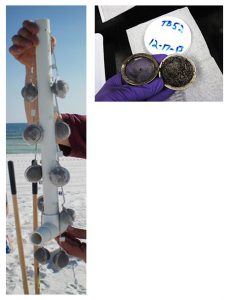Studies Shows Beach Environment Enhanced Oil Degradation, But Still May Take 30 Years
– OCTOBER 1, 2019
Researchers at Florida State University and the Georgia Institute of Technology analyzed degradation processes of oil that was deposited along Gulf of Mexico beaches following Deepwater Horizon. They found that small millimeter-size oil particles and thin oil films that coated sand grains disappeared within a year, facilitated by the large surface-to-volume ratio of the small particles and films that allowed space for microbial colonization and biodegradation. In contrast, the degradation of golf-ball sized sediment-oil-agglomerates (SOAs or tarballs) with a smaller surface-to-volume ratio is a lengthier process. Using a novel in-situ experimental setup, the researchers followed the degradation of buried SOAs for three years and, based on decay rates, estimated that the SOA decomposition would take about 30 years. The degradation of the same SOAs kept in a dark lab environment would take approximately 100 years, highlighting the key role of the beach environment and its microbial community in the oil degradation process.
The researchers published their findings in two studies, one in Marine Pollution Bulletin: Degradation of Deepwater Horizon oil buried in a Florida beach influenced by tidal pumping and one in Scientific Reports: Decomposition of sediment-oil-agglomerates in a Gulf of Mexico sandy beach.
Oil associated with Deepwater Horizon reached the Florida panhandle sandy beaches of the Florida panhandle on June 22, 2010. Waves generated by the distant passage of Hurricane Alex, deposited oil mousse high onto the beaches and strong winds blew an oily sea spray across the beach, coating the sands with oil. Mixing of oil and sand in the swash zone produced large SOAs that were buried in the beach. The deposition of oil continued, and by the end of July, sands in the upper 70 cm of the beach were stained brown and veined by dark compacted layers of SOAs. Questions arose about the length of time that this oil would persist in Florida beaches.
To assess the degradation of the oil particles and oil films coating the sands, the teams of Markus Huettel and Joel Kostka quantified concentration changes of aliphatic and aromatic oil components; assessed microbial communities’ abundance, composition, and succession; and determined the transport of oxygen and carbon dioxide from June 2010-July 2011. To assess oil degradation in buried SOAs, the team conducted an in-situ experiment from October 2010-December 2013 using golf-ball size standardized SOAs that were embedded in the beach. They compared oil decomposition in buried SOAs to laboratory-incubated SOA material to determine the beach environment’s contribution to oil degradation.
Study author Markus Huettel explained the method for their in-situ experiment, “We combined and homogenized Deepwater Horizon SOAs that we collected at Pensacola Beach one week after the oil came to shore and filled the resulting SOA material in 100 golf-ball-size stainless steel teaballs. Five pairs of such standardized SOAs were attached to a vertical PVC pipe and buried in the beach, positioned at 10, 20, 30, 40 and 50 cm sediment depth, respectively. The ten arrays were removed from the beach one at a time over a period of 3 years. Using this method, we could follow the degradation of the SOAs at different sediment depths over time.”
Huettel emphasized the role of beaches as biocatalytical filters at the land-ocean interface, “Microbial degradation activities typically are most efficient when oxygen and warm temperatures are present, and this was supported by the tidal groundwater table oscillations in the beach. When the ebb tide sets in, the groundwater level in the beach drops, drawing air into the highly permeable beach sand. This ‘beach inhaling’ carries oxygen and heat into the sand, boosting the biodegradation activities within the beach. The rising groundwater table of the following flood acts like a piston pump, pushing air enriched in carbon dioxide out of the beach and moisture from deeper sands into the upper drier beach layers. This ‘beach exhaling’ is beneficial for the decomposition processes in the beach as gases resulting from the oil decomposition can reduce aerobic microbial degradation processes, and microbes need moisture to ‘drink.’ The beach, breathing in tidal rhythm, thus has similarities to an organism that aerobically ‘digests’ the buried oil, inhaling oxygen and exhaling carbon dioxide. After most oil had been decomposed, the microbial community of the beach reversed to a community typical to an unpolluted beach environment.”
Data for the study published in Marine Pollution Bulletin are archived at the National Center for Biotechnology Information (NCBI) under BioProject ID PRJNA294056 and publicly available through the Gulf of Mexico Research Initiative Information & Data Cooperative (GRIIDC) at DOI 10.7266/N7765CV9, DOI 10.7266/N7XW4HBZ, DOI 10.7266/N7BZ64J8, DOI 10.7266/N73J3BGD, DOI 10.7266/N7PZ56VV, DOI 10.7266/N7PG1Q83, DOI 10.7266/N7T72FZZ, DOI 10.7266/N78C9TSB, and DOI 10.7266/N7MG7N1S.
Data for the study published in Scientific Reports are publicly available through the Gulf of Mexico Research Initiative Information & Data Cooperative (GRIIDC) at DOI 10.7266/n7-wjj4-dq16, DOI 10.7266/n7-jjcn-y650, DOI 10.7266/n7-r0ca-f740, DOI 10.7266/n7-kzth-6056, DOI 10.7266/n7-jgbx-p395, and DOI 10.7266/n7-kavs-t279.
The Marine Pollution Bulletin study’s authors are Markus Huettel, Will A. Overholt, Joel E. Kostka, Christopher Hagan, John Kaba, Wm. Brian Wells, and Stacia Dudley.
The Scientific Reports study’s authors are Ioana Bociu, Boryoung Shin, Wm. Brian Wells, Joel E. Kostka, Konstantinos T. Konstantinidis, and Markus Huettel.
By Nilde Maggie Dannreuther. Contact maggied@ngi.msstate.edu with questions or comments.
************
This research was made possible in part by grants from the Gulf of Mexico Research Initiative (GoMRI) to the
- Center for the Integrated Modeling and Analysis of Gulf Ecosystems II (C-IMAGE II),
- Center for the Integrated Modeling and Analysis of Gulf Ecosystems III (C-IMAGE III),
- Deepsea to Coast Connectivity in the Eastern Gulf of Mexico (DEEP-C) consortium,
- Florida State University for the project A systems approach to improve predictions of biodegradation and ecosystem recovery in coastal marine sediments impacted by oil spill,
- Florida State University through the Florida Institute of Oceanography (FIO 4710-1101-00-1) for the project Penetration, Accumulation and Degradation of BP DWH Oil in Florida Sandy Beaches, and
- Florida State University through the Northern Gulf Institute (NG1 191001-306811-03) for the project Deepwater Horizon Oil Deposition in Gulf of Mexico Beaches Phase 2: Recovery of the Beach Sedimentary Environment.
This research was also supported by the National Science Foundation (OCE-1044939 and OCE-1057417).
The Gulf of Mexico Research Initiative (GoMRI) is a 10-year independent research program established to study the effect, and the potential associated impact, of hydrocarbon releases on the environment and public health, as well as to develop improved spill mitigation, oil detection, characterization and remediation technologies. An independent and academic 20-member Research Board makes the funding and research direction decisions to ensure the intellectual quality, effectiveness and academic independence of the GoMRI research. All research data, findings and publications will be made publicly available. The program was established through a $500 million financial commitment from BP. For more information, visit https://gulfresearchinitiative.org/.
© Copyright 2010-2019 Gulf of Mexico Research Initiative (GoMRI) – All Rights Reserved. Redistribution is encouraged with acknowledgement to the Gulf of Mexico Research Initiative (GoMRI). Please credit images and/or videos as done in each article. Questions? Contact web-content editor Nilde “Maggie” Dannreuther, Northern Gulf Institute, Mississippi State University (maggied@ngi.msstate.edu).







